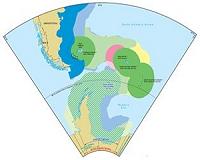 |
Washington (AFP) Aug 19, 2010 Scientists said Thursday they found a large underwater plume of oil that spewed from BP's ruptured Gulf of Mexico well, as a government expert grew cautious on earlier assertions most of the oil has disappeared. The growing doubts came as US authorities said that crews would not completely seal the well until September, more than a month after plugging the site that triggered the world's worst-ever maritime oil spill. Writing in the journal Science, Woods Hole Oceanographic Institution marine biologists said they measured an oily underwater cloud stretching 35 kilometers (22 miles), two kilometers (one mile) wide) and 200 meters (650 feet) thick. The observations were made in late June, several weeks before the ruptured wellhead was capped. But the scientists said the plume was not dissipating as rapidly as expected despite widespread use of dispersants. Challenging US government estimates that most of the oil has dissipated, the authors said deep-sea microbes were degrading the plume only slowly and predicted the oil would endure for some time. "We've shown conclusively not only that a plume exists, but also defined its origin and near-field structure," said lead author Richard Camilli. The oil already "is persisting for longer periods than we would have expected," he added. "Many people speculated that the sub-surface oil droplets were being easily downgraded. Well, we didn't find that. We found that it was still there." However, he acknowledged that the biologists did not know the state of the plume two months after the spill and did not know enough to say if it was toxic. US and BP officials earlier this month proclaimed that about three-quarters of the oil which gushed into the Gulf had been cleaned up or dispersed through natural processes. But testifying before Congress on Thursday, Bill Lehr, the National Oceanic and Atmospheric Administration scientist who wrote the report, said the figures were estimates and he was still assessing the effectiveness of chemical dispersants. The report "should not be interpreted as saying that somehow the spill is over with," Lehr said. "You do not tell Admiral Allen that he's got to wait three months while your report goes through peer review," Lehr said, referring to the federal government's spill clean-up chief Thad Allen. "But that will come." Representative Ed Markey, a member of President Barack Obama's Democratic Party and strong advocate of environmental protection, criticized the initial release of the findings. "People want to believe that everything is okay and I think this report and the way it is being discussed is giving many people a false sense of confidence regarding the state of the Gulf," Markey said. Representative Darrell Issa, a Republican and sharp critic of Obama, accused the White House of manipulating science for political ends. "This is yet another in a long line of examples where the White House's preoccupation with the public relations of the oil spill has superseded the realities on the ground," Issa said in a statement. Around 4.9 million barrels of oil are believed to have spewed from the fractured wellhead before it was capped last month. US officials say that of that amount, 800,000 barrels were contained and funneled up to ships on the surface. The Woods Hole team used a robotic submarine equipped with an underwater mass spectrometer to detect and analyze the plume, making repeated horizontal sweeps to ascertain its size and chemical composition. The plume was then tracked for a distance of about 35 kilometers before the approach of Hurricane Alex forced the scientists to turn back. "The plume was not a river of Hershey's Syrup," said Christopher Reddy, a marine biochemist. "But that's not to say it isn't harmful for the environment." The damaged well was capped on July 15. Earlier this month, BP engineers plugged the site with heavy drilling fluid and then sealed it with cement. Allen, the clean-up chief, said that the definitive "bottom kill" that seals up the site would not occur before the Labor Day holiday on September 6. "It's impossible to provide a more specific timeline," Allen told a news conference. The wait is partially to give BP time to test a replacement blowout preventer to ensure the new one can withstand pressure, he said.
Share This Article With Planet Earth
Related Links Powering The World in the 21st Century at Energy-Daily.com
 Oil firm upbeat despite Falklands setback
Oil firm upbeat despite Falklands setbackStanley, Falkland Islands (UPI) Aug 19, 2010 Rockhopper Exploration remains upbeat about prospects for a commercially feasible hydrocarbons find in the Falkland Islands waters despite poor results from a well drilled in the southern part of North Falkland Basin. Prospects for oil in the deep waters around the British Overseas territories have seesawed between strong optimism and despair as companies funded by mostly British shareh ... read more |
|
| The content herein, unless otherwise known to be public domain, are Copyright 1995-2010 - SpaceDaily. AFP and UPI Wire Stories are copyright Agence France-Presse and United Press International. ESA Portal Reports are copyright European Space Agency. All NASA sourced material is public domain. Additional copyrights may apply in whole or part to other bona fide parties. Advertising does not imply endorsement,agreement or approval of any opinions, statements or information provided by SpaceDaily on any Web page published or hosted by SpaceDaily. Privacy Statement |